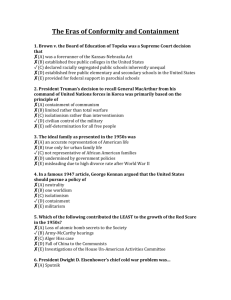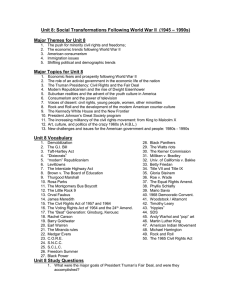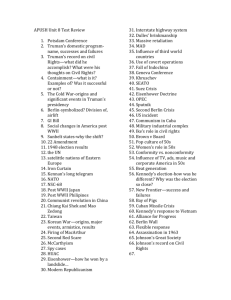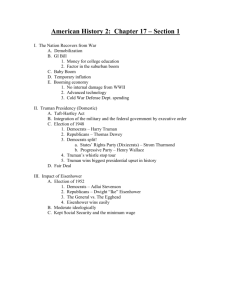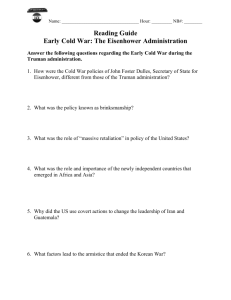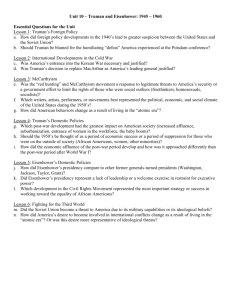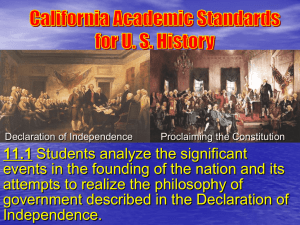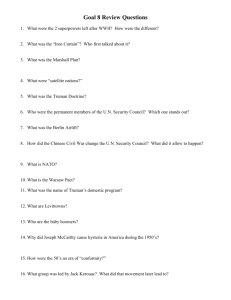Units 24 and 23 Topic Outline Sheet
advertisement
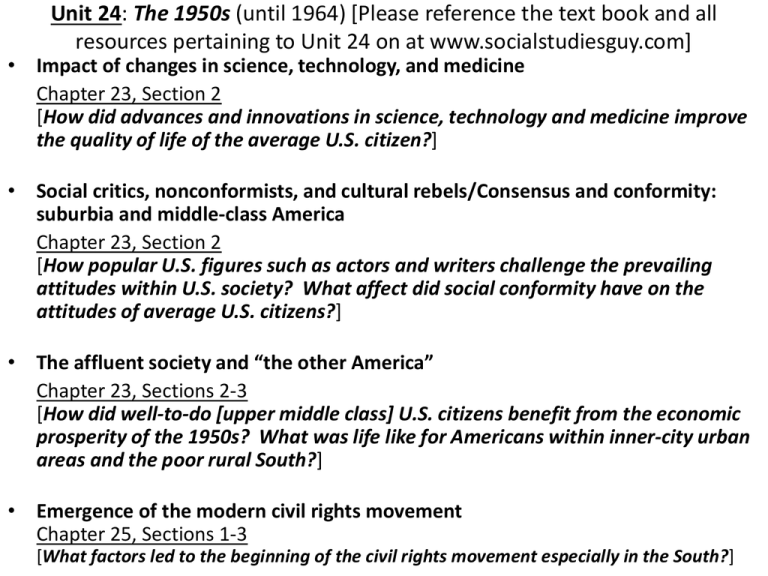
Unit 24: The 1950s (until 1964) [Please reference the text book and all resources pertaining to Unit 24 on at www.socialstudiesguy.com] • Impact of changes in science, technology, and medicine Chapter 23, Section 2 [How did advances and innovations in science, technology and medicine improve the quality of life of the average U.S. citizen?] • Social critics, nonconformists, and cultural rebels/Consensus and conformity: suburbia and middle-class America Chapter 23, Section 2 [How popular U.S. figures such as actors and writers challenge the prevailing attitudes within U.S. society? What affect did social conformity have on the attitudes of average U.S. citizens?] • The affluent society and “the other America” Chapter 23, Sections 2-3 [How did well-to-do [upper middle class] U.S. citizens benefit from the economic prosperity of the 1950s? What was life like for Americans within inner-city urban areas and the poor rural South?] • Emergence of the modern civil rights movement Chapter 25, Sections 1-3 [What factors led to the beginning of the civil rights movement especially in the South?] Essential Vocabulary Unit 24 Terms [all fair game for next test] • • • • • • • • • • • • • • • • • • • • • • • Suburbia Levittown The Baby Boom G.I. Bill White/Blue Collar jobs Franchises Transistors/calculators ENIAC/UNIVAC Antibiotics/chemotherapy C.P.R. Jonas Salk I Love Lucy The Adventures of Ozzie and Harriet Father Knows Best T.V. Quiz shows 3-D films Rock-n-Roll Elvis Presley Edward R. Murrow The Beat Movement James Dean The Poverty Line Michael Harrington’s The Other America • • • • • • • • • • • • • • • • • • Urban Renewal The Bracero Program Lorraine Hansberry’s A Raisin in the Sun White Flight Termination Policy Poverty in Appalchia Juvenile delinquency Rosa Parks NAACP Thurgood Marshall Brown vs. Topeka Board of Education C.O.R.E. Montgomery Bus Boycott Little Rock School Crisis Freedom Riders James Meredith Violence in Birmingham in 1963 Civil Rights Act of 1964 Unit 23: The U.S. and the Early Cold War [Please reference the text book and all resources pertaining to Unit 24 on at www.socialstudiesguy.com] • Impact of the Cold War on American society • Chapter 22, Section 3 [How did U.S. foreign policy toward the U.S.S.R. impact the lives of Americans?] • • Chapter 22, Sections 2-3 [How effective were the Cold War policies of Truman, Eisenhower and Kennedy in confronting crises related to communism in Asia?] The Red Scare and McCarthyism Chapter 22, Section 3 [What affect did Senator McCarthy’s hearings have on Americans’ view of the Red Scare?] Diplomatic strategies and policies of the Eisenhower and Kennedy administrations Chapter 22, Section 4, Chapter 23, Section 1, Chapter 24, Sections 1-2 [How effective were the foreign policies of Eisenhower and Kennedy at maintaining world peace? How effective were the policies of Eisenhower and Kennedy and advancing the strategic interests of the United States?] The Cold War in Asia: China, Korea, Vietnam, and Japan • Truman and containment Chapter 22, Section 2 [How effective was the Truman containment doctrine?] • Origins of the Cold War Chapter 22, Section 1 [What was the origin of the Cold War?] Essential Vocabulary Unit 23 Terms [all fair game for next test] • • • • • • • • • • • • • • • • • • • • • • Cold War Red Scare Subversion Loyalty review program H.U.A.C. J. Edgar Hoover Alger Hiss Julius and Ethel Rosenberg McCarthyism McCarren Act Watkins v. United States, 1957 ICBMs Long range bombers Brinkmanship Korean War Taiwan Crisis Suez Crisis C.I.A. Eisenhower Doctrine U-2 Incident Sputnik Military-industrial complex • • • • • • • • • • • • • • • • • • George Kenan Space race Apollo 13 NASA Containment S.E.A.T.O. Truman firing of Gen. McArthur Chinese Revolution Berlin Airlift Marshall Plan N.A.T.O. Warsaw Pact The Long Telegram Crisis in Iran Bert the Turtle Duck and Cover drills Fall out shelters The Kitchen Debate
